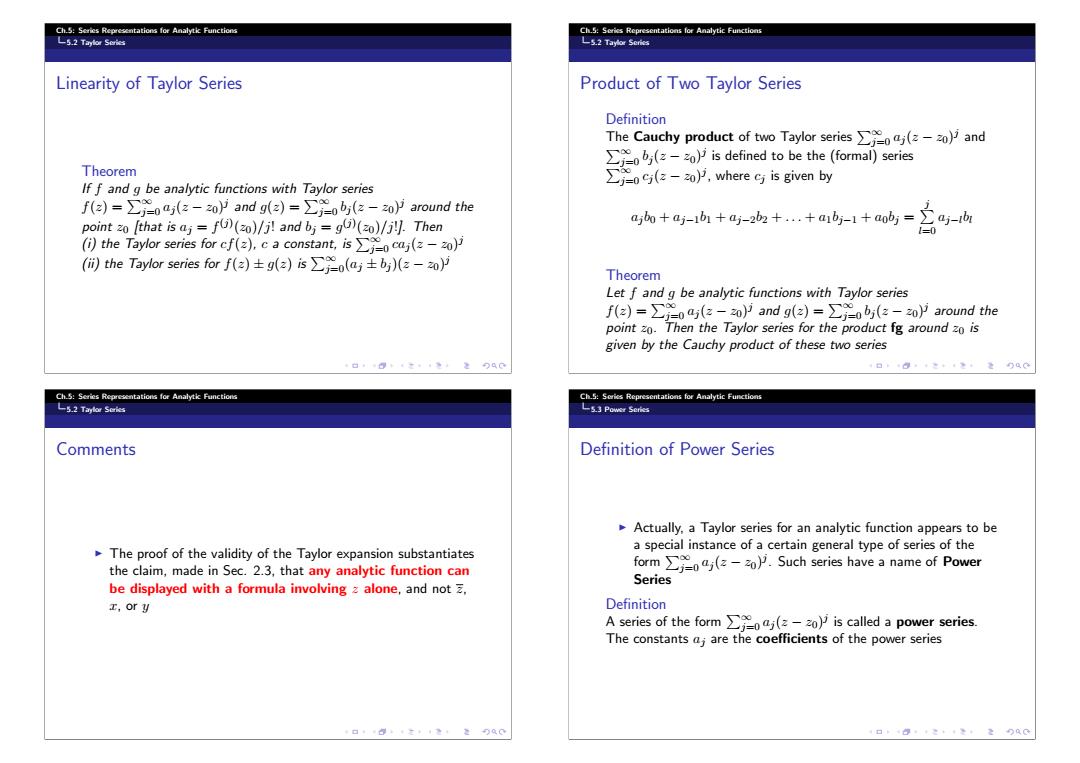正在加载图片...

Ch.5:Series Representations for Analytic Functions Ch.5:Series Representations for Analytic Functions L5.2 Tayfor Series L5.2 Taylor Series Linearity of Taylor Series Product of Two Taylor Series Definition The Cauchy product of two Taylor series (-z)and (is defined to be the (formal)series Theorem oSe-2o户,where5 is given by If f and g be analytic functions with Taylor series f(2)=aj(=-z0)and g(=)=(z-zo around the point zo [that is aj=f)(zo)/j!andbj=g)(zo)/j Then a,n+a5-1b1+a-2b++a1b-1+b与=24y-h =0 (i)the Taylor series for cf(=).c a constant,isc() (份the Taylor series forf(a)±g(a)is∑eo(a±b)(a-2oP Theorem Let f and g be analytic functions with Taylor series f(=)=oaj(z-zo)i and g(z)=(2-z0)around the point zo.Then the Taylor series for the product fg around zo is given by the Cauchy product of these two series 4口18。+之+1老+意0G Ch.5:Series Representations for Analyti Functions Ch.5:Scrics Representations for Analytic Functions L5.2 Taylor Sories 5.3 Power Series Comments Definition of Power Series Actually,a Taylor series for an analytic function appears to be The proof of the validity of the Taylor expansion substantiates a special instance of a certain general type of series of the the claim,made in Sec.2.3,that any analytic function can form(.Such series have a name of Power Series be displayed with a formula involving z alone,and not z. 工,ory Definition A series of the form(z)is called a power series. The constants aj are the coefficients of the power seriesCh.5: Series Representations for Analytic Functions 5.2 Taylor Series Linearity of Taylor Series Theorem If f and g be analytic functions with Taylor series f(z) = ∞j=0 aj (z − z0)j and g(z) = ∞j=0 bj (z − z0)j around the point z0 [that is aj = f(j)(z0)/j! and bj = g(j)(z0)/j!]. Then (i) the Taylor series for cf(z), c a constant, is ∞j=0 caj (z − z0)j (ii) the Taylor series for f(z) ± g(z) is ∞j=0(aj ± bj )(z − z0)j Ch.5: Series Representations for Analytic Functions 5.2 Taylor Series Product of Two Taylor Series Definition The Cauchy product of two Taylor series ∞j=0 aj (z − z0)j and ∞j=0 bj (z − z0)j is defined to be the (formal) series ∞j=0 cj (z − z0)j , where cj is given by aj b0 + aj−1b1 + aj−2b2 + ... + a1bj−1 + a0bj = j l=0 aj−lbl Theorem Let f and g be analytic functions with Taylor series f(z) = ∞j=0 aj (z − z0)j and g(z) = ∞j=0 bj (z − z0)j around the point z0. Then the Taylor series for the product fg around z0 is given by the Cauchy product of these two series Ch.5: Series Representations for Analytic Functions 5.2 Taylor Series Comments The proof of the validity of the Taylor expansion substantiates the claim, made in Sec. 2.3, that any analytic function can be displayed with a formula involving z alone, and not z, x, or y Ch.5: Series Representations for Analytic Functions 5.3 Power Series Definition of Power Series Actually, a Taylor series for an analytic function appears to be a special instance of a certain general type of series of the form ∞j=0 aj (z − z0)j . Such series have a name of Power Series Definition A series of the form ∞j=0 aj (z − z0)j is called a power series. The constants aj are the coefficients of the power series��������������